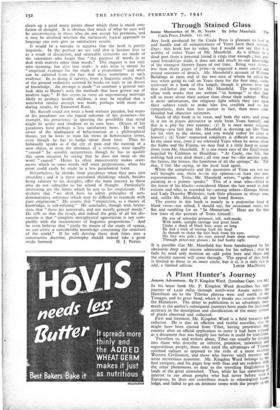A Plant Hunter's Journey
Assam Adventure. By F. Kingdon Ward. (Jonathan Cape. 125. 6d.) IN his latest book Mr. F. Kingdon Ward describes his 1937 journey of z,roo miles through north-west Assam across the Himalayas on to the Tibetan plateau west and north of the Tsangpo, and its great bend, where it breaks sou.hwards through the Himalayas. The delay in publication is an advantage, inas- much as the author's subsequent journeys have made for increased accuracy in the description and classification .of the many
of plants observed and collected. First and foremost, Mr. Kingdon Ward is a field botanist and collector. He is also an efficient and tactful traveller, else he might have been ejected from Tibet, having penetrated that country after an official application to enter it had been refused in a document that was happily lost before it could be translated. species
Travellers to, and writers about, Tibet can usually be divided into those who describe an inferior, primitive, unwashed and superstitious people, those who extol the advantages of Tibetan spiritual culture as opposed to the evils of a more maternal Western Civilisation, and those who forever smell mystery an write mysterious nonsense. Mr. Kingdon Ward belongs to the first category, and his pages hop with fleas and are redolent with the other phenomena so dear to the travelling Englishman 11 lands of the great unwashed. Thus, while he has something interest to say about peoples who had never before seen 9 European, he does not contribute much to ethnological know- ledge, and failed to get on intimate terms with the people in the manner of Madame David-Neel or Mr. Marco Pallis. At the same time he records gratefully how almost everywhere he met with kindness and hospitality from this simple and charming people.
Mr. Kingdon Ward was constantly on thennove, and his style is correspondingly jumpy and restless. In three months he covered more than eight hundred miles " mostly through un- explored country, and in regions botanically even more unknown." For such untiring zeal botanists owe him a debt of gratitude for a valuable contribution to plant geography, aspects of which are discussed in an interesting chapter at the end of the book, whilst the fruits of his travels should soon be beautifying many English gardens.
The Eastern Himalayas and Western China is the habitat par excellence of that most beautiful of all shrubs, the rhododendron, and as a rhododendron specialist Mr. Kingdon Ward is justly famous. It is not so very many years since the R. Ponticum alone graced our gardens • now it is only necessary to visit the annual show of the Rhododendron Society to realise how much we owe to the explorers of this region. It is indeed remarkable how these, and many other plants, which grow in the great rain forests of Assam and on the Alpine uplands of temperate Tibet, accustomed as they are to moist, warm summers and dry snowy winters, have adapted themselves to our variable climate, and the inference is that the original adaptability gained during the Tertiary mountain-building epoch, when Tibet was raised from the Mesozoic sea, still persists in plants of this region. It is also curious to reflect that less than one hundred years ago Tibet had little interest to the botanist, principally because the only portion of that country then explored was the Chang Tang, a desolate district with no more than fifty odd species of flowering plants.
But Mr. Kingdon Ward is a thoroughly catholic botanist. He is as much prepared to risk his neck on some lofty crag in quest of a minute primula as he is ready to endure fever in a humid rain forest in quest of a stately rhododendron. Moun- taineers will regret that an equally intense topographical enthusiasm did not lead him closer to the tremendous peak of Namcha Barwa, 25,446 feet, which stands in the bend of the Tsangpo, but his accounts of the crossing of the Great Himalayan range and the gorges of the Tsangpo make good, if hurried, reading. There are fifteen photographs, divided among the flora (but none, unfortunately, of rhododendrons in bloom), the country and the people, and a map on a somewhat small scale.
F. S. SMYTHE.































 Previous page
Previous page